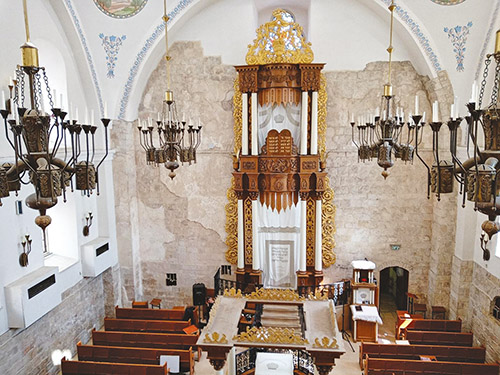



(The historical information in this article is based on Dr. Eyal Davidson’s book הרובע היהודי וכל נתיבותיו published by Yad Yitzchak ben Tzvi.)
In the Jewish quarter of the old city of Yerushalayim stands a tall and impressive synagogue known as the Hurva. The Hebrew word “hurva” means ruins, so why is that the name of this gorgeous synagogue?
The story of the Hurva goes back a few hundred years to the Ashkenazi Jewish community in Yerushalayim under Ottoman rule. Prior to the year 1700 CE, only a small Jewish community lived within the walls of the Old City. In Poland, Jews had just suffered terribly from the gezerot tach v’tat, the Chmielnicki pogroms, and were terribly wounded both physically and emotionally. Enter Rabbi Yehuda HaChasid, a charismatic leader who began to travel around Europe and convince followers both physically and financially to return to Yerushalayim for the ultimate redemption. In October 1700, Rabbi HaChasid and his followers arrived in Yerushalayim. They had reached their destination! However, their joy was short-lived as the rabbi passed away six days later. He left behind him impoverished followers in a new country who still needed to get their bearings and figure out how to survive in this new land.
In their desperation, they began to borrow money from the Arab locals. When the time came to repay the loans, they had no means of repayment. Even though a Jewish fundraising campaign in Europe tried to help them, it did not yield sufficient funds. The Arab creditors responded in 1720 by attacking the Ashkenazi community of the Old City and burning down the small, local synagogue. Since then, the area has been known as “Hurvat (the ruins of) Rabbi Yehudah HaChasid.”
Toward the end of the 18th century, the students of the Vilna Gaon began their waves of aliyah to Eretz Yisroel. Due to the lack of Ashkenazi infrastructure in Yerushalayim, they made their way to Tzfat. In 1813, a plague in Tzfat devastated a large percentage of the Jewish community. In response, a group led by Rav Menachem Mendel Mishklov, a student of the Vilna Gaon, left Tzfat to restore the Jewish community in Yerushalayim.
Rav Mishklov led a mission to petition the Ottoman emperor in Istanbul and as a result, Jews were given permission to once again settle in their old courtyards in Yerushalayim. The debt was also declared void as many generations had already passed (to the great disappointment of the Arab locals). However, permission was not yet granted to restore the synagogue.
In 1831, Muhammed Ali of Egypt gained control of Eretz Yisrael and with him came a more open-minded approach to non-Muslims. It was under his reign that permission was finally given to rebuild various synagogues, including the Menachem Zion Synagogue, upon the ruins of Rabbi Yehudah HaChasid’s original shul.
In the mid-19th century, the Jewish community of Yerushalayim grew by leaps and bounds. The small Menachem Zion Synagogue was no longer big enough. In 1855, with the help of Moses Montefiore, permission was finally granted by the Ottoman authorities to build the Hurva Synagogue. In conformity to Muslim law, it was clearly stated that this was not a “new” synagogue, rather an old one that was being restored.
The Jewish community then turned to Assad Effendi, a Turkish architect who had been sent to Yerushalyim by the Sultan to repair buildings on the Temple Mount, and offered him a large sum to oversee the building of the new synagogue. The structure that he designed did not look anything like a synagogue of Jerusalem. It looked more like a Turkish mosque! After nine years of construction, the building of the Hurva was completed with its dome towering high within the old city. Nothing like this had ever been permitted under Muslim rule.
It is in this historic synagogue that the first Ashkenazi Chief Rabbi, Rabbi Avraham Yitzchak HaCohen Kook, was inaugurated! It was in this historic synagogue that British High Commissioner Sir Herbert Samuel was welcomed by the Jews of Eretz Yisrael during the British Mandate. And it is no surprise that this symbol of Jewish return to Yerushalyim was blown up by the Jordanian Legion in 1948 during Israel’s War of Independence.
In 1967, when Israel regained control of the Old City, there was much debate about what to do about “the Hurva.” Initially, just one arch was restored. Then in 2002, the decision was made to rebuild the Hurva exactly as it had originally looked. The project was completed in 2010 and there was much discussion about what the function of the synagogue would be. Ultimately, it was decided that a Chareidi Kollel, of the type similar to the original builders of the Hurva, the students of the Vilna Gaon, would be given the opportunity to learn on a daily basis in the restored synagogue. One who visits the Hurva on a regular weekday can go up to the women’s section and listen to the voice of Torah once again being learned in this historic synagogue!
Hava Preil is an enthusiastic licensed Israeli tour guide. She grew up on the Upper West Side of Manhattan and holds an MA in Judaic studies. Hava has developed and taught accredited courses in Tanach and Jewish Ethics for Naaleh/Woodmont College and Cybersem. She currently lives in Givat Ze’ev, Israel with her family. Hava can be reached at IL:054-844-1579, USA: 845-391-0438 or at Havapreil@gmail.com









